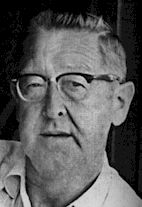Frank Freese
Frank Freese wrote an earlier, little known work called "A textbook for Statistical Transients." Meant to help teach the basics, it established a readable and simple style that made his work popular and well known some 40 years later when the Western Mensuration group reprinted it for everyone attending the 1997 Lake Tahoe Meeting.
Frank was at the USFS Southern Experiment Station for several years, and it was there that he worked with Gene Avery who wrote the foreword to this reprint.
Freese was an infantryman, "a ground-pounder" in WWII, and sweated through some tough campaigns, like the battle of the bulge. He emerged with a silver star, an ability to dig in frozen ground, and a practical approach to life.
He never married, and after retirement continued to attend meetings of former staff from the Madison Wisconsin Forest Products Lab where he spent the last part of his career with the USFS. He refused to have a phone in the house. A different thinker, Frank Freese.
He is fondly remembered in an era of modern unreadable statistical texts. Frank always had a modesty and a genuine respect for people that came through in his writing. His books were clear, easy to read, and always had examples to help you unravel the details. He thought of statistics as useful – not a test of your ability to endure pain.
Frank was surprised to be honored by the Western Mensuration group, and not really aware that his books were still used as texts so many years after they were written. His friends, who looked after him in the last days, said that he was very pleased with this recognition by a group of younger biometricians.
It’s a long way from the carbon copies and printing methods Freese used to the laser printing word processor that reproduced this classic work. Martin Ritchie and Jerry Allen have the thanks of all of us for this wonderful idea.
The world could use a few more men who strive to make things simple. Frank Freese set a good example.